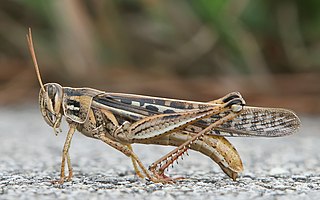
Orthoptera is an order of insects that comprises the grasshoppers, locusts, and crickets, including closely related insects, such as the bush crickets or katydids and wētā. The order is subdivided into two suborders: Caelifera – grasshoppers, locusts, and close relatives; and Ensifera – crickets and close relatives.

Locusts are various species of short-horned grasshoppers in the family Acrididae that have a swarming phase. These insects are usually solitary, but under certain circumstances they become more abundant and change their behaviour and habits, becoming gregarious. No taxonomic distinction is made between locust and grasshopper species; the basis for the definition is whether a species forms swarms under intermittently suitable conditions; this has evolved independently in multiple lineages, comprising at least 18 genera in 5 different subfamilies.

The Rocky Mountain locust is an extinct species of grasshopper that ranged through the western half of the United States and some western portions of Canada with large numbers seen until the end of the 19th century. Sightings often placed their swarms in numbers far larger than any other locust species, with one famous sighting in 1875 estimated at 198,000 square miles (510,000 km2) in size, weighing 27.5 million tons and consisting of some 12.5 trillion insects, the greatest concentration of animals ever speculatively guessed, according to Guinness World Records.

Grasshoppers are a group of insects belonging to the suborder Caelifera. They are amongst what are possibly the most ancient living groups of chewing herbivorous insects, dating back to the early Triassic around 250 million years ago.

The migratory locust is the most widespread locust species, and the only species in the genus Locusta. It occurs throughout Africa, Europe, Asia, Australia and New Zealand. Because of the vast geographic area it occupies, which comprises many different ecological zones, numerous subspecies have been described. However, not all experts agree on the validity of some of these subspecies.

Bandwings, or band-winged grasshoppers, are the subfamily Oedipodinae of grasshoppers classified under the family Acrididae. They have a worldwide distribution and were originally elevated to full family status as the Oedipodidae. Many species primarily inhabit xeric weedy fields, and some are considered to be important locusts:

The Caelifera are a suborder of orthopteran insects. They include the grasshoppers and grasshopper-like insects, as well as other superfamilies classified with them: the ground-hoppers (Tetrigoidea) and pygmy mole crickets (Tridactyloidea). The latter should not be confused with the mole crickets (Gryllotalpidae), which belong to the other Orthopteran sub-order Ensifera.
Orthopterology is the scientific study of the order Orthoptera, which includes grasshoppers, crickets, locusts and some other insects. Someone that studies in this field is an orthopterist.

Acriopsis, commonly known as chandelier orchids or 合萼兰属 is a genus of flowering plants in the family Orchidaceaes. Orchids in this genus are epiphytic herbs with spherical or cylindrical pseudobulbs, creeping, branched rhizomes, thin white roots, two or three leaves and many small flowers. The flowers are non-resupinate with the lateral sepals joined along their edges and have spreading petals and a three-lobed labellum. The column has projections that extend hood-like beyond the anther.

The Dulit frogmouth is a little-known species of bird in the frogmouth family, Podargidae, with a patchily recorded distribution in the mountain forests of northern and central Borneo to which it is endemic. The species is monotypic.

Metarhizium acridum is the new name given to a group of fungal isolates that are known to be virulent and specific to the Acrididea (grasshoppers). Previously, this species has had variety status in Metarhizium anisopliae ; before that, reference had been made to M. flavoviride or Metarhizium sp. describing an "apparently homologous and distinctive group" of isolates that were most virulent against Schistocerca gregaria in early screening bioassays.

Aularches miliaris is a grasshopper species of the monotypic genus Aularches, belonging to the family Pyrgomorphidae. A native of South and Southeast Asia, the bright warning colours of this fairly large grasshopper keep away predators and their defense when disturbed includes the ejection of a toxic foam.

Valanga nigricornis, the Javanese grasshopper, is a species of grasshopper in the subfamily Cyrtacanthacridinae of the family Acrididae. It is found in southeastern Asia, the type location being Singapore. It was first described by the German zoologist Hermann Burmeister in 1838. There are more than twenty subspecies, most of which are endemic to different island groups; the subspecies V. nigricornis nigricornis is the type for the genus Valanga.

Valanga irregularis belongs to the family Acrididae. The distribution is restricted in the Australian tropics and subtropics. The species is the largest grasshopper of the continent. Usually the animal lives a solitary mode of life.

Buforania rufa, sometimes called the rufous toadhopper, is a spur-throated grasshopper native to Western Australia.

The Locust Plague of 1874, or the Grasshopper Plague of 1874, occurred in the summer of 1874 when hordes of Rocky Mountain locusts invaded the Great Plains in the United States and Canada. The locusts swarmed over an estimated 2,000,000 square miles (5,200,000 km2) and caused millions of dollars' worth of damage. Residents described swarms so thick that they covered the sun for up to six hours.

Kakaduacris minuta is a species of short-horned grasshopper in the family Acrididae. It is the only species in the genus Kakaduacris. It is found in north Australian savannas.

Stenocatantops vitripennis is a species of short-horned grasshopper in the family Acrididae. It is found in north Australian savannas in the wet season.

Tolgadia is a genus of short-horned grasshopper in the family Acrididae. It is found in north Australian savanna forest and woodland sites. The genus includes:



















